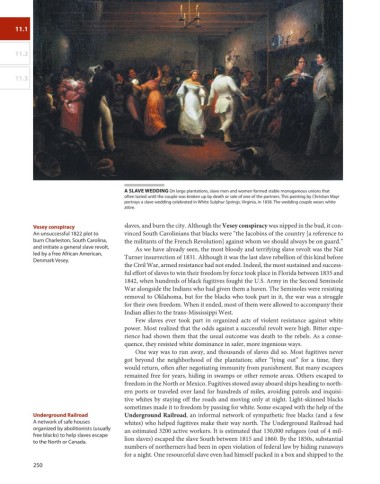Page 283 - American Stories, A History of the United States
P. 283
11.1
11.2
11.3
A SLAVE WEDDING On large plantations, slave men and women formed stable monogamous unions that
often lasted until the couple was broken up by death or sale of one of the partners. This painting by Christian Mayr
portrays a slave wedding celebrated in White Sulphur Springs, Virginia, in 1838. The wedding couple wears white
attire.
Vesey conspiracy slaves, and burn the city. Although the Vesey conspiracy was nipped in the bud, it con-
An unsuccessful 1822 plot to vinced South Carolinians that blacks were “the Jacobins of the country [a reference to
burn Charleston, South Carolina, the militants of the French Revolution] against whom we should always be on guard.”
and initiate a general slave revolt, As we have already seen, the most bloody and terrifying slave revolt was the Nat
led by a free African American,
Denmark Vesey. Turner insurrection of 1831. Although it was the last slave rebellion of this kind before
the Civil War, armed resistance had not ended. Indeed, the most sustained and success-
ful effort of slaves to win their freedom by force took place in Florida between 1835 and
1842, when hundreds of black fugitives fought the U.S. Army in the Second Seminole
War alongside the Indians who had given them a haven. The Seminoles were resisting
removal to Oklahoma, but for the blacks who took part in it, the war was a struggle
for their own freedom. When it ended, most of them were allowed to accompany their
Indian allies to the trans-Mississippi West.
Few slaves ever took part in organized acts of violent resistance against white
power. Most realized that the odds against a successful revolt were high. Bitter expe-
rience had shown them that the usual outcome was death to the rebels. As a conse-
quence, they resisted white dominance in safer, more ingenious ways.
One way was to run away, and thousands of slaves did so. Most fugitives never
got beyond the neighborhood of the plantation; after “lying out” for a time, they
would return, often after negotiating immunity from punishment. But many escapees
remained free for years, hiding in swamps or other remote areas. Others escaped to
freedom in the North or Mexico. Fugitives stowed away aboard ships heading to north-
ern ports or traveled over land for hundreds of miles, avoiding patrols and inquisi-
tive whites by staying off the roads and moving only at night. Light-skinned blacks
sometimes made it to freedom by passing for white. Some escaped with the help of the
Underground Railroad Underground Railroad, an informal network of sympathetic free blacks (and a few
A network of safe houses whites) who helped fugitives make their way north. The Underground Railroad had
organized by abolitionists (usually an estimated 3200 active workers. It is estimated that 130,000 refugees (out of 4 mil-
free blacks) to help slaves escape
to the North or Canada. lion slaves) escaped the slave South between 1815 and 1860. By the 1850s, substantial
numbers of northerners had been in open violation of federal law by hiding runaways
for a night. One resourceful slave even had himself packed in a box and shipped to the
250

